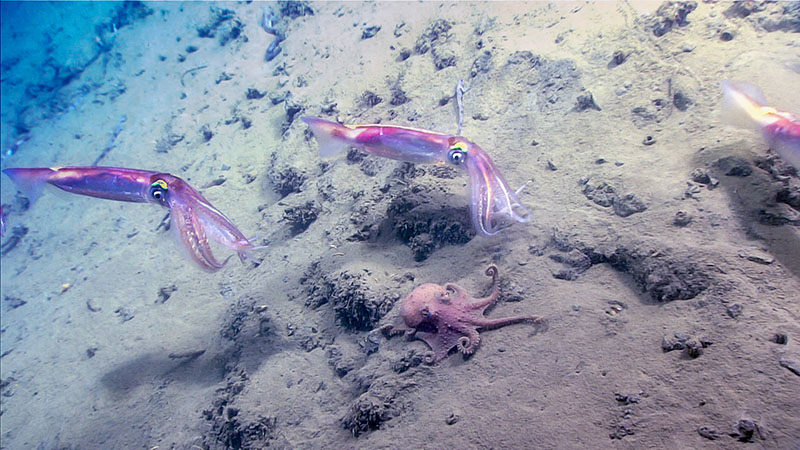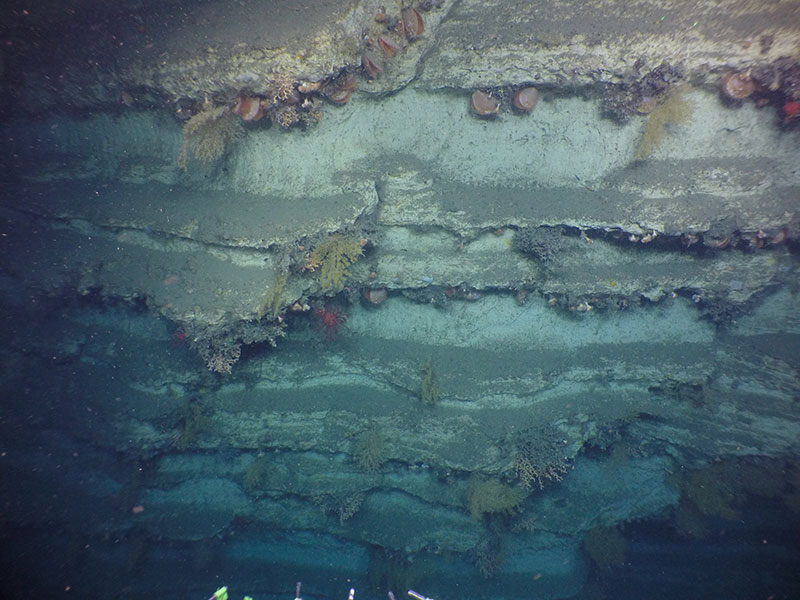
By Cheryl Morrison, Research Geneticist, U.S. Geological Survey
About 35 miles off the coast of North Carolina, the continental shelf dramatically slopes off from a depth of approximately 200 meters (656 feet) to more than 2,000 meters (6,561 feet) toward the continental rise and eventually the deep and flat abyssal plain.
Carved into the shelf from North Carolina through Canada are 40 undersea canyons that may be 16 to 160 kilometers (10 to 100 miles) long, with some deeper than the Grand Canyon. The complex topography and geology in canyons provides many habitat types including steep walls, rocky outcrops, and ledges where sensitive deep-sea coral communities often live, as well as sedimented areas where additional fish and invertebrate species thrive. Dynamic currents, including upwelling and strong tidal fluxes, resuspend sediments and organic matter, creating high sedimentation rates and providing prevalent nutrients and food resources. Mid-water fishes and invertebrates may interact with bottom-dwelling organisms in canyons, creating productive feeding opportunities. The combination of dynamic flows, increased food supply, and complex geology interact to create hotspots of biodiversity. For these reasons, canyons continue to be a high priority for federal and state agencies charged with managing offshore resources.
Three named canyons occur within the DEEP SEARCH study region off the coast of North Carolina: Keller, Hatteras, and Pamlico. While the majority of recent canyon research and exploration has focused on canyons between Virginia and New England, the North Carolina canyons have yet to be explored in detail. The autonomous underwater vehicle (AUV) Sentry has surveyed a handful of locations within the North Carolina canyons, revealing the presence of octocorals on steep canyon walls.
The North Carolina canyons may be unique relative to those further north due to their location where strong current systems collide. The cold Labrador Current from the north meets the warm Gulf Stream and Virginia Currents from the south, where the latter currents are deflected offshore at Cape Hatteras. The colliding currents create a dynamic exchange of inshore and offshore waters as well as one of the sharpest thermal boundaries known in the world’s coastal oceans. Regional differences in fishes, invertebrates, and deep-sea corals have been documented north and south of Cape Hatteras, with origins likely related to the barrier created by steep temperature gradients and tolerances of organisms.

Illex squid swim above an octopus (Bathypolypus) in Keller Canyon. Image courtesy of the NOAA Office of Ocean Exploration and Research, Windows to the Deep 2018. Download larger version (jpg, 1.5 MB).
Documenting what species occur in deep waters north and south of Cape Hatteras and sampling abundant species for estimates of genetic connectivity will allow us to determine whether colliding currents act as barriers to dispersal among sensitive deep-sea fauna, creating population structuring that may be considered for effective resource management planning. During the current DEEP SEARCH mission, we are planning to dive on three of the North Carolina canyons—Keller, Hatteras, and Pamlico.

Three-dimensional view of Keller Canyon with depths ranging from 200 to 1,600 meters (656 to 5,250 feet). The main canyon channel carves into the continental shelf (dark red). This complex canyon has many tributary canyons. Image courtesy of Jason Chaytor, U.S. Geological Survey. Download larger version (jpg, 716 KB).
Keller Canyon is the only one of the Carolina canyons that incises the shelf, but less so than the canyons further to the north. Images from the AUV Sentry revealed the presence of octocorals and anemones. A ridge within this complex canyon was surveyed by the Deep Discoverer remotely operated vehicle during the Windows to the Deep Okeanos Explorer expedition in 2018, where white nephtheid corals were observed, along with sea pens, hydroids, pycnogonid sea spiders, squid, and Bathypolypus octopus. Numerous areas of diffuse gas venting at depths between 50-930 meters (164-3,051 feet) have been noted from multibeam surveys.

An active water column included many mid-water organisms, such as shrimps, snipe eels, and squid, that were feeding at an intra-canyon ridge off Pea Island, North Carolina. Image courtesy of the NOAA Office of Ocean Exploration and Research, Windows to the Deep 2018. Download larger version (jpg, 616 KB).
Hatteras Canyon was explored using research submersibles nearly half a century ago, and sea pens, sea stars and sea cucumbers were noted. More recent surveys using the AUV Sentry revealed the presence of octocorals on steep canyon walls at 1,500 meters (4,921 feet) depth. Multibeam data detected diffuse gas venting between 180-375 meters (590-1,230 feet) depth, and bacterial mats were observed on the Windows to the Deep Expedition (see image).

Bacterial mats indicative of methane seepage observed at a canyon off Pea Island, North Carolina. Image courtesy of the NOAA Office of Ocean Exploration and Research, Windows to the Deep 2018. Download larger version (jpg, 663 KB).
Pamlico Canyon lies south of Hatteras Canyon and is the least explored of the three target canyons, though octocorals were documented on canyon walls by the AUV Sentry in 2016. This canyon minimally incises the shelf break approximately 20 miles off the North Carolina Outer Banks, with the main axis extending about 17 miles from a depth of 400 to 3,000 meters (1,312 to 9,842 feet), but then continues offshore for over 100 miles to 5,000 meters (16,404 feet) depth. This site may harbor the highest diversity of corals, invertebrates, and fishes and is the least explored, making it a high priority for DEEP SEARCH investigations.

Alvin explored Pamlico Canyon off the coast of North Carolina and observed stunning rock walls covered in a diversity of corals. Image copyright Woods Hole Oceanographic Institution, courtesy of DEEP SEARCH 2018 – BOEM, USGS, NOAA. Download larger version (jpg, 4.3 MB).
Determining how rugged canyon features influence the distribution and abundance of both commercially important and vulnerable organisms requires advanced technologies and multi-disciplinary science objectives. The remotely operated vehicle Jason will allow visual exploration of the exposed rock surfaces along the steep canyon walls that provide insight into the geologic history of the canyon. Sampling of corals and associated fauna as well as seep fauna (if encountered) for biodiversity and biogeography will be a priority on canyon dives, along with sediment and water collections, all while logging temperature, salinity, and depth along our transects to characterize the physical environment.